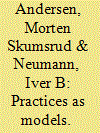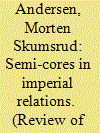|
|
|
Sort Order |
|
|
|
Items / Page
|
|
|
|
|
|
|
| Srl | Item |
| 1 |
ID:
113848


|
|
|
|
|
| Publication |
2012.
|
| Summary/Abstract |
The everyday meaning of 'practice' is something like concrete 'doings' or 'what is being done' in a social setting. Its everyday counter-concept is theory. Intuitively, this may lead us to think of practices as what is really going on in the world, as opposed to theories or models. This commonsensical meaning of practices reinforces the separation between theory and empirical reality. We argue that such an understanding has informed much of the ongoing 'practice turn' in International Relations. We also argue that this is not necessarily an efficient way of conceptualising 'practices', because practices might end up being too general a concept to be analytically useful. To counter this, we argue, one must be explicit about practices at the level of models, that is, in fictional representations of the world. This can help in studying them as endogenous phenomena, and not only as the practical counterpart of some other phenomena, or emanating from unspoken theoretical assumptions of, for example, conscious rule-following behaviour, interests, identities, structures and so on. As an illustration of what a model of practice might look like, we include a case study of Iroquois diplomacy as practice. Using a model, without relying on unstated assumptions exogenous to it, we represent this particular case through assuming that both the agents and their social environments emerge through practices.
|
|
|
|
|
|
|
|
|
|
|
|
|
|
|
|
| 2 |
ID:
144053


|
|
|
|
|
| Summary/Abstract |
Recently, the field of International Relations has seen increased interest in international hierarchy, and also an upswing in the analytical study of imperial logics of rule. Nonetheless, existing structural models of empire focus on core-periphery dynamics, and so cannot explain polities that display elements of both core and periphery. Therefore, I offer the new concept of ‘semi-cores’. Semi-cores are a specific form of historical political associations whereby certain imperial provinces are different from the others in terms of the close relationships it maintains with the imperial metropolis. Semi-cores are different by virtue of being relatively similar. The conceptualisation of semi-cores is followed by a section illustrating its logic, examining the relatively unfamiliar cases of Scotland and Norway and their position within the Danish and British empires, respectively. Although being separate imperial provinces, these were tightly connected to an imperial core. This concept helps us better understand imperial logics, and in the process shows how cultural factors can be formalised into accounts of structural logics of rule, impacting our understanding of both historical and contemporary hierarchical international affairs.
|
|
|
|
|
|
|
|
|
|
|
|
|
|
|
|
|
|
|
|
|